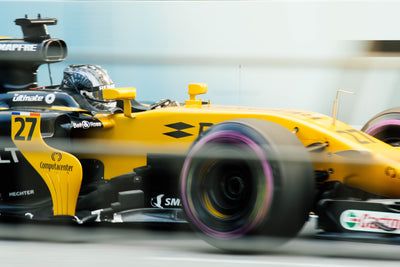On all US Domestic orders.

Behind the Seams: The Construction of Racing Suits
The roar of the engine, the blur of the track, the relentless push for peak performance - these are the hallmarks of the thrilling world of motorsport. But beneath the sleek exteriors of racing cars lies another crucial element: the racing suit. Often overshadowed by the roaring engine or the aerodynamic marvel of the vehicle itself, the racing suit plays a vital role in ensuring driver safety and performance.
Let's delve into the fascinating world behind the seams, exploring the intricate construction of racing suits and how they provide a trifecta of benefits: fire protection, comfort, and aerodynamic advantages.
The Building Blocks: Materials for Safety and Performance
The foundation of a racing suit lies in the materials meticulously chosen for their specific properties. Here's a breakdown of the key players:
- Nomex®:This flame-retardant fiber is a champion in racing. Its unique structure helps prevent the propagation of flames, providing vital protection against heat and burns in an accident.
- Kevlar®:Renowned for its immense strength, Kevlar® fibers are often woven into the outer layers of racing suit They offer superior abrasion resistance, safeguarding drivers from cuts and scrapes during high-speed crashes.
- Para-aramid blends:These blends combine the fire resistance of Nomex® with the added strength of other aramid fibers, creating a lightweight yet robust material ideal for racing suit
- Cotton:While not the primary fire-retardant component, breathable cotton linings can enhance comfort by wicking away moisture and regulating body temperature.
Layering Up for Protection
Racing suits are not simply one-piece fabric wonders. They are meticulously constructed with multiple layers, each serving a distinct purpose:
- Outer Layer:This layer, often made from Nomex® or aramid blends, acts as the first line of defense against flames and abrasion.
- Mid-Layer:This layer, constructed from breathable materials like Nomex® or cotton blends, provides thermal insulation and moisture management, keeping drivers cool and comfortable.
- Inner Layer:This layer, typically made from soft, breathable fabrics like cotton or fire-retardant blends, offers additional comfort and prevents skin irritation.
Safety First: Engineering Fire Resistance
The ability to withstand extreme heat is paramount in a racing suit. Fire resistance is achieved through a combination of factors:
- Inherent Properties:Materials like Nomex® have an inherent ability to self-extinguish and resist melting, even when exposed to high temperatures.
- Char Formation:When exposed to flames, the outer layer of the suit chars, creating a protective barrier that slows down heat transfer to the inner layers.
- Moisture Management:Breathability plays a vital role. Keeping moisture away from the fire-resistant materials ensures their effectiveness.
Comfort Counts: Keeping Drivers Cool and Collected
A comfortable driver is a focused driver. Racing suits combat the heat generated by high-speed driving and physical exertion through strategic design features:
- Breathable Materials: Fabrics like Nomex® and cotton blends allow for air circulation, keeping drivers cool and dry.
- Paneling: Strategically placed panels of breathable mesh or moisture-wicking fabrics further enhance ventilation.
- Lighter Weight: Advancements in materials have led to lighter-weight suits that offer superior fire protection without compromising comfort.
Aerodynamics: Slipping Through the Air with Style
Beyond safety and comfort, racing suits also play a subtle role in aerodynamics. A well-designed suit can offer slight aerodynamic advantages:
- Snug Fit: A close-fitting suit reduces drag, allowing the car to slice through the air with minimal resistance.
- Stretch Panels: Strategically placed stretch panels allow for freedom of movement while maintaining a streamlined silhouette.
- Smooth Design: Minimizing seams and other surface irregularities further reduces wind resistance.
If you are ready to explore the world of cutting-edge racing suits, visit Fast Racer today to discover various suits sourced from the world’s leading brands. Don't compromise—gear up with Fast Racer.


Leave a comment